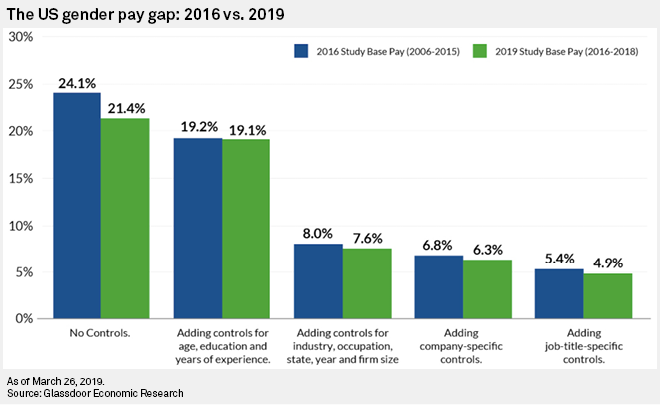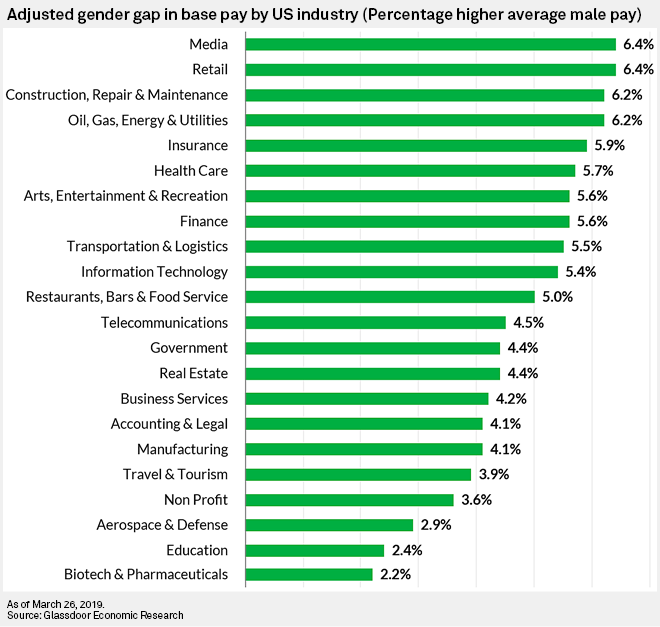As companies and governments around the world increase their focus on closing the gender pay gap, there is a growing debate about how to define and measure the disparity in compensation between men and women in the workplace.
The most recent season of annual shareholder meetings in the U.S. has aligned with U.K. firms' mandated reporting of their gender pay data, including the mean and median gap. A 2019 study from the crowdsourced employment site Glassdoor Inc. found the U.S. adjusted pay gap had dropped to 4.9%, down from 5.4% in a 2016 analysis.
With this influx of data from both companies and employees, there is a growing question around how the pay gap should best be measured. Many U.S. companies and even sites such as Glassdoor use an adjusted figure to statistically control for differences in education, job title, industry and other factors. But others say these adjustments obscure deeper inequities in the hiring and promotion process, leading to a greater risk of legal or regulatory action.

Kim Churches, CEO of the advocacy group American Association of University Women, said companies would do better to report more information than less, both to ensure pay equity and to get ahead of looming regulations around reporting.
She pointed to a ruling this year from a federal judge that reinstated pay-data reporting provisions with the Equal Employment Opportunity Commission. The provisions, which had been suspended in 2017 by the Trump administration, require most employers to report pay information by race, ethnicity and sex. The EEOC said in May that it expects to begin collecting the data for calendar years 2017 and 2018 in mid-July 2019, with a due date of Sept. 30.
AAUW has also been working with Congress to get the Paycheck Fairness Act passed. The bill — which prohibits the use of salary histories and requires employers to justify any pay disparities between men and women — passed the U.S. House of Representatives in March but faces an uphill battle in the Senate.
"It will continue to be a big issue in 2020," Churches said of the bill.
Natasha Lamb, managing partner at Arjuna Capital LLC, an investment firm that focuses on sustainable and impact investing, first began calling for the disclosure of pay gap information in 2015 with a shareholder proposal at eBay Inc. The online retailer ultimately agreed to conduct a pay equity study, reporting in 2016 that among U.S. employees, women make 99.8% of the total compensation that men make in the same job and at the same grade level.
"At this point we've pressed 22 companies to reveal that data — nine in Silicon Valley, nine on Wall Street and four big retailers," Lamb said, calling this "a huge step."
Now, though, she is pushing companies to publish their unadjusted median pay gap.
"We filed follow-up proposals with 12 companies we had already engaged with in Silicon Valley and Wall Street and asked for the second half of the story, for this median number," Lamb said, noting that the median pay gap reveals whether women are holding as many high-paying jobs or leadership roles as men.
Citigroup Inc., for instance, made headlines when it disclosed in January that compensation for its global female employees is 71% of the median for men. By comparison, on an adjusted basis, female employees at the company earn on average 99% of what their male counterparts earn.
"It's important that women and people of color are getting paid fairly for the work that they're doing today, but it's also important that they move into higher paying jobs and into positions of leadership. Because from our perspective, the investor perspective, that's where performance benefits," said Lamb. "That's where there is better decision making. That's where there is more innovation and improved financial performance because of that diversity of thought."
Arjuna filed follow-up proposals at companies such as Adobe Systems Inc., Amazon.com Inc., American Express Co., Bank of America Corp., Bank of New York Mellon Corp., Facebook Inc., Google LLC parent Alphabet Inc., Intel Corp., JPMorgan Chase & Co., Mastercard Inc. and Wells Fargo & Co.
All of the aforementioned companies recommended shareholders vote against these proposals. Where meetings have already occurred, shareholders at Adobe, Amazon, American Express, Bank of America, BNY Mellon, Intel, JPMorgan and Wells Fargo voted the proposals down.
Some companies, like Facebook, argued median pay measures representation of women and men more than pay equity. Facebook noted that despite recent progress on increasing the number of women employed at Facebook, it still has more male than female employees, particularly in technical roles that "tend to attract higher pay due to demand for specialized skills, and at senior levels."
Facebook is set to hold its annual shareholder meeting on May 30.
Another Silicon Valley giant, Alphabet, which will hold its shareholder meeting June 19, said in its own opposition statement, "Google believes that compensation should be based on what one does, and not who one is."
The information technology sector, according to Glassdoor, has in fact made progress on closing its gender pay gap. The industry saw its adjusted pay gap fall to 5.4% between 2016 and 2018, down from 5.9% between 2006 and 2015, Glassdoor said. Compared to other sectors, Glassdoor said IT now falls in the middle of the pack of U.S. industries while media and retail, at 6.4%, have the largest adjusted gaps.
Daniel Zhao, Glassdoor senior economist and data scientist, acknowledged in an interview that some progress has been made, but argued there is "a lot of room to improve."
"There's still a lot of male-dominated jobs in the tech industry, like software engineers, for example," he said.
Zhao said that when it comes to the adjusted gender pay gap versus the median or unadjusted gap, "We believe that both of those numbers are really important. You can't really understand the problem with only one of them."
While Glassdoor's 2019 report found the adjusted U.S. gender pay gap dropped to 4.9%, it reported an unadjusted pay gap of 21.4%, down from roughly 24% three years ago.
Zhao sees the median gap as revealing the broader "societal factors that push women into lower-paid careers," while the adjusted gap is "very good for answering the specific question of, 'Do women earn equal pay for equal work?'"
Lamb warned that the "worst outcome" would be for companies to use their published adjusted gap to declare mission accomplished when it is "just not true."
Moreover, although Glassdoor's adjusted figure for the U.S. is significantly smaller than the median figure, Zhao said it should not be ignored.
"A 4.9% difference sounds smaller because people have been hearing this 20% gap for a long time, but that's actually a very significant number," he said. "That's tens of thousands of dollars over a career."

Subscribe to our ESG newsletter, and listen to an episode of the ESG Insider podcast focused on gender pay equality efforts. |




